Even when the code for software seems to be perfectly written, it decays over time due to the ever-changing technology ecosystem and changing user needs. Small bugs and issues pile up gradually across releases and eventually lead to major product inefficiencies and huge maintenance costs.
Thankfully, refactoring is here to prevent such outcomes. It has become a preferred practice for software development teams because it is proactive and cost-efficient. This article will outline when to approach product refactoring, how to perform refactoring, the associated best practices, and more.
Let’s get the definition out of the way
Refactoring is a process of altering the already written code while keeping the functionality intact. This strategy helps in improving the structure of the system without hampering the external code behavior. In essence, refactoring is used to clean up the code and improve its extensibility, readability, and maintainability.
When To Consider Refactoring?
Refactoring should be a routine process to keep the code up to date and reduce business costs. While refactoring does not explicitly concentrate on eliminating the bugs, it does work towards preventing future bugs from transpiring. Ideally, this process should be carried out before adding any new features and functionalities to the code. Besides this, refactoring can also be done to understand the code better.
How To Perform Code Refactoring?
Refactoring should be done before adding new features to the product to ensure that it does not impact the code or product behavior. There are various techniques to undergo code refactoring. Some of the widely used techniques are as follows:
1. Red-Green Refactoring
This technique is one of the most basic engineering patterns to facilitate test-driven development. It breaks down the process into various small steps. “Red” comes first, where the specific development requirements will be reviewed. In this step, the test will be written without any implementation code. “Green” is the follow-up to Red, where the implementation code is written to qualify the project through testing. Lastly, the “Refactor” step – here, the developer deeps dive into the code, identifies the weak points, and tweaks the code with necessary improvements.
2. Extract Method
This method intends to improve the overall readability of the code by providing required clarifications, regularizing the structure, and addressing the complexities. This technique transfers the code from the original method to the newly established method. The new methods are labeled to describe the functionality of code blocks to make it easier for development teams to combine the whole structure of the code.
3. Simplifying Method
While the extraction method enhances the readability, the simplifying method simplifies the code for better interpretation. Refactoring can be done by simplifying the method calls or conditional expressions within the code. Simplifying method calls focuses on simplifying the parameters by adjusting the interactions of various classes. And conditional expression refactoring focuses on simplifying the code logic by tweaking the conditional statements. So, the overall approach of simplification depends on the refactoring goals.
4. Composing Method
This method is utilized when the code functions are very lengthy and complex to execute. This technique reorganizes the code by eliminating duplication or breaking it into small fragments. Some of the common methods to break the code include the inline method, split temporary variable, and extraction. Inline refactoring is one of the most popular methods, as it removes redundant methods from code and replaces them with appropriate content. But if fragmentation can solve the problem, the extraction method is a better option. This technique cuts the code into smaller chunks, moves the fragments, and replaces them with appropriate content.
Best Practices for Code Refactoring
- Advance planning: Refactoring is a helpful but very time-consuming process. So, it is always essential to have refactoring processes planned. Moreover, the code size must also be decided, as refactoring larger codes can lead to blocking risks. To avoid the same, proper planning is very important.
- Run regular code tests: All the dependencies and adjustments need to be taken care of while the refactoring process is undertaken. The right technology partner can help you identify every possible adjustment, enhancement, and adaptation.
- Refactoring before product enhancements: Undergoing the refactoring process before adding the product improvements can be a time-consuming process, but it reduces the possibility of technical debts in the future.
Get Your Refactoring Process Right with Us
To sum up, it can be considered that refactoring is not a one-time effort but an ongoing maintenance project. The routine refactoring process can clean, organize, and improve your codes and lead to effective working processes.
The right technology partner can get your refactoring process right and ensure that all your codes are well-organized and run as expected. Get a free consultation today to save valuable time and effort.



